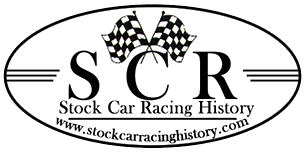The 1949 Season
The Day It All Began -- June 19, 1949
By Greg Fielden
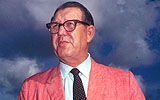 |
| Bill France Sr. had a vision which has lasted 50 years. |
On December 14, 1947, in a smoke-filled room at the Streamline Hotel in Daytona Beach, Florida, thirty-five men sat at a table and laid the ground work for a national sanctioning body to tie up the loose threads and govern the sport of stock car racing.
Chairman of the meeting on that Sunday afternoon was Big Bill France, who had directed stock car races in the South in 1947. In the next three days a set of by-laws, rules and guidelines were drawn up.
France had begun the 1947 season as director of the National Championship Stock Car Circuit (NCSCC), a sanctioning body he founded that used the slogan, "Where The Fastest That Run, Run the Fastest". The young promoter also staged events under the Stock Car Auto Racing Society, but the call letters spelled SCARS so that idea was quickly scrapped.
Red Vogt, renowned mechanic from Atlanta and one of those attending the meeting has generally been given credit for coming up with the name for the new organization; and on February 21, 1948, the National Association for Stock Car Auto Racing was incorporated. France was elected President of NASCAR with E.G. "Cannonball" Baker of Indianapolis as National Commissioner. Eddie Bland of Jacksonville was the new Vice-president; Bill Tuthill of Hartford, Secretary; and race driver Marshall Teague, Treasurer. "The purpose of this association is to unite all stock car racing under one set of rules; to set up a benevolent fund and a national point standings system whereby only one stock car driver will be crowned national champion," declared France. "Every track and every area has a 'national champion' of every type of racing. This has so confused the sports writers that they give up in disgust after trying to give the public an accurate picture."
NASCAR proposed the sanctioning of three different divisions in 1948, and curiously the "Strictly Stock" class was listed as the headlining attraction. Support divisions were the Modified Stocks and Roadsters.
The Strictly Stocks, which would eventually become the Winston Cup Grand National Tour, never made it off the ground in 1948.
No new cars had been built from 1942 to 1946, and the auto manufacturers were still trying to "catch up" on the shortage. A race fan would not stand for the idea of new showroom cars being beat up on a race track while he was still driving the old 1940 clunker. There was an influx of old pre-war coupes which was the "meat" of stock car racing. The Roadsters fizzled out soon thereafter, and France had to rely on the Modifieds to make his bread and butter. He did, however, permit the late model Strictly Stocks to compete in Modified races. They were driven sparingly.
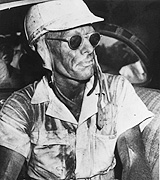 |
| Red Byron was first Modified Champion. |
Fifty-two championship Modified meets comprised the 1948 slate, and Red Byron of Atlanta was crowned national champion.
France had the ball rolling, but his concept of having one set of rules to determine one national champion was not entirely a success. In 1949, NASCAR had to rival the National Stock Car Racing Association (NSCRA), the United Stock Car Racing Association (USCRA), the National Auto Racing League (NARL), and the American Stock Car Racing Association (ASCRA) for supremacy in the stock car field. All had point systems which would determine a "national champion" and the journalists still had to juggle several names in the sport sections when penning stories about stock car racing titlists.
The sport was getting nowhere fast.
France tried to revitalize the Strictly Stocks, a class of racing designed for the late model family sedan. He figured the racing enthusiast would be interested in a division which featured automobiles the general public was buying off the showroom floor. Besides, no other sanctioning body had utilized the idea, and it might substantiate NASCAR's claim of having a true "national champion".
On February 27, 1949, an experimental Strictly Stock race was staged at the Broward Speedway, a massive two-mile paved track in Southern Florida. The five lap, 10-mile race was the "novice" event of a three-race card, falling in behind the top billing of a 100-mile National Grand Prix Roadster race and a 25-mile European Sports Car race.
Most of the "name" drivers participated in the 100-miler for low-slung, chopped-up Roadsters, a classification France was also trying to rebuild for the 1949 season.
The event was won by Bob Flock of Atlanta. Future Indianapolis 500 champion Jim Rathmann finished second. Tom Demetry won the Sports Car event and Benny Georgeson of Fort Lauderdale, Florida, captured the very first Strictly Stock race in a Buick. Eddie Mitchell of Defiance, Ohio came in second in a Mercury.
It was difficult for France to evaluate the impact of the Strictly Stocks since it was merely a supplementary event at Broward. For the most part, everyone forgot about it.
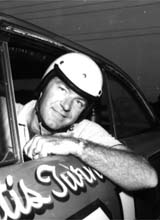 |
| Curtis Turner was in the first NASCAR race. |
However, early in 1949, NASCAR found itself being challenged by the NSCRA, a fledgling operation directed by Olin Bruton Smith, now Chairman of Charlotte Motor Speedway. Both NASCAR and NSCRA were fighting for the same cars and drivers in the same general area. Smith's new organization was a threat to France, who hurriedly prepared to stage another Strictly Stock race in the early summer.
This time, however, the Strictly Stocks would be the main attraction, and a "marathon" 150-miler would be presented in Charlotte on June 19, 1949, with a purse of $5,000 on the line.
The surprise announcement caught nearly everyone off guard, but France was not worried about attracting a full field of cars since Strictly Stocks were just that. And anyone who owned a full size American made passenger car was eligible to enter. He felt confident the 33-car field would be filled when the green flag was waved.
The battleground was a rough three-quarter mile dirt track surrounded by scraggly fences of undressed lumber misappropriating the name "speedway". The track, built by Harvey and Pat Charles on property leased from Mr. & Mrs. C.C. Allison, had opened on July 11, 1948, and had hosted Modified races for parts of two seasons.
Most of the Modified hotshots showed up with late model sedans. There were, however, four top drivers who were not permitted to enter for reasons NASCAR listed as "actions detrimental to auto racing".
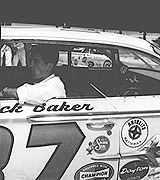 |
| Buck Baker was once a milk man. |
During his short tenure as Treasurer of NASCAR, Teague noticed that the gate receipts at some tracks were substantially greater than the guaranteed purse which was posted. He wanted NASCAR to adopt a policy used by the American Automobile Association which paid 40-percent of the gate receipts into the purse for the Indy Car drivers whenever and wherever they raced. Teague withdrew from two spring NASCAR races in protest.
Buddy Shuman, Speedy Thompson and Ed Samples were not allowed to compete because they had allegedly deposited a few hundred thumb tacks on a track before a NASCAR Modified meet a couple of weeks earlier. Jimmy Thompson had been cleared of similar charges, placed on a one-year probation period, and was granted permission to compete.
Qualifying trials were held on Saturday, June 18th. Bob Flock, a man with majestic blue eyes and a volatile temper, posted the quickest lap of 67.958 miles per hour in the Davis Brothers '46 Hudson. Tim Flock, a fidgety, nervous youngster, was second in the Buddy Elliott '49 Oldsmobile; and Red Byron, the original Huckleberry Finn of racing, was third fastest in the Parks Novelty Co. '49 Olds. Otis Martin, a scraggly mountaineer wearing farmer's overalls, qualified fourth in a '48 Ford, and smiling jokester Fonty Flock was fifth in a '49 Hudson. The Flock Brothers were doing very well.
Other qualifiers included Curtis Turner, a womanizing lumberjack in a '46 Buick Roadmaster; Hubert Westmoreland, an eccentric moonshiner in a '47 Ford; and Bill Blair, a laid-back greasy little fellow who put a Lincoln through the timing lights.
Lining up twelfth was Jim Roper, who had hauled his Lincoln all the way from Great Bend, Kansas. Roper had become aware of the race from the syndicated "Smilin' Jack" comic strip authored by Zack Mosely, an auto racing fan who often slipped racing news into his art work.
Another notable in the field was Sara Christian, who was regarded as "The Leading Woman Stock Car Driver in the Country" in early NASCAR press releases.
Christian qualified thirteenth in a '47 Ford, one spot ahead of Sam Rice, a quiet and polite man whose trademark was a full-brimmed hat.
Others in the field included Jim Paschal, tatooed up to his armpits with ships and anchors; Herb Thomas, a skinny tobacco farmer; Jack Smith, a portly Georgia boy with a pure leather neck; and Buck Baker, a big-eared ex-door-to-door milk man. All these would eventually be represented in the National Motorsports Press Association Hall of Fame.
Nine different makes of automobiles would go to the post: Lincoln, Hudson, Ford Olds, Cadillac, Buick, Chrysler, Kaiser and Mercury.
The gates were scheduled to open at noon on June 19th, but with an unexpectedly long line of cars and spectators leading into the speedway grounds, France began letting them in several minutes early.
Crowd estimates by Houston A. Lawing, NASCAR's first Publicity Director, were as high as 22,500, but France later said about 13,000 had paid to get in. It was a healthy turnout. Maybe the Strictly Stocks could support themselves after all.
The field of thirty-three cars snarled around the track three times behind the pace car. The crowd, full of anticipation, were on their collective feet for this historic occasion. Seventeen rows were filled by cars with unimaginative color schemes - some not painted at all. Lots of black cars, a couple of red ones, a gray one. And then there was a bright green flag in the hands of Starter Alvin Hawkins.
Into the first turn they sped - the leaders disappearing into clouds of billowing dust which rose well above the undressed wooden fence. Wheel to wheel, hub to hub they came. Fenders popping. Throttles snapping. Spectators cheering.
For five dusty trips around, Bob Flock's bulky Hudson led the way. Then a black Lincoln with five-foot, six-inch Bill Blair peeping over the steering wheel took command, skimming past Flock as they roared down the backstretch.
Greasy little Bill Blair, broadsliding over the bumps and chuck-holes, left his comrades choking on the dust from his whitewall heels.
Bob Flock was one of the first drivers out of the race. His Hudson retired to the pit area and was parked in a pool of oil that had oozed from his motor. He then accepted relief driving chores for Sara Christian, who climbed out of her Ford after thirty or so punishing miles.
Blair continued to tackle the gently banked corners with reckless abandon, passing each and every car with bold, daring thrusts. Meanwhile, as the half-way point rolled around, perhaps a dozen or more cars were motionless in the unmanicured pit area. Drivers, with helmet in hand, studied geysers of steam shooting skyward from tortured, overheated engines.
On Lap 107, Lee Petty, a new face to the racing game, found himself holding on for dear life as his Buick - a vehicle he drove from Level Cross, North Carolina to Charlotte two days earlier - tumbled endlessly through the third turn, coming to rest on all four wheels. Petty unbuckled his seat belt, got out of the car and sat down on the upper crest of the track, staring out over the countryside in a dejected muse. "I was just sitting there thinking about having to go back home and explain to my wife where I'd been with the car," Petty said later. It was the first and to be the only crash of the afternoon, and Petty suffered nothing more serious than a cut on his cheek.
Bill Blair pressed on, lapping the rapidly fading field at least once. His sights were set on the black and which checkered flag and the $2,000 that went to the driver who got there first.
But the casualty epidemic struck Blair's fleet Lincoln fifty laps from paydirt. He brought his R.B. McIntosh-owned car down the grassy pit lane, steam whining as it gushed from the radiator, his quest for racing immortality ruined by mechanical problems.
Blair's misfortune allowed Glenn Dunnaway to pick up first place on lap 151. The Gastonia, North Carolina driver arrived trackside Sunday morning without a ride. But Hubert Westmoreland let Dunnaway, the more experienced pedal-pusher, tighten the seat belt at race time.
Funny page reader Jim Roper moved up to second place, but overheating problems forced him to slacken his pace. He finished the race slowly, cruising the inside of the track.
Dunnaway's Ford breezed across the finish line three full laps ahead of Roper's ailing Lincoln. He was congratulated by all. The handful of newspaper writers wrote their stories accordingly.
But as twilight descended on Charlotte, Major Al Crisler, NASCAR's first Technical Inspector was summoned to conduct a teardown of Dunnaway's winning Ford. Some officials had wondered about the apparent stability of the car as it passed through the bumpy turns.
Crisler said the Westmoreland-Dunnaway Ford was equipped with "altered rear springs" and therefore it did not fit the guidelines of the Strictly Stocks. No modifications of any kind were allowed except for a reinforcing steel plate on the right front wheel in the interest of safety to prevent lug nuts from pulling through the rims on conventional wheels.
The '47 Ford was a bootlegger car designed to haul heavy loads of illegal moonshine, and "spreading the springs" was common in vehicles used for that purpose.
Westmoreland howled like a coyote when NASCAR disqualified his car and awarded the $2,000 first prize to Roper, who had completed 197 of the scheduled 200 laps. Westmoreland was so incensed that he filed a lawsuit for $10,000 in damages against NASCAR.
But Judge John J. Hayes threw the case out of Greensboro, North Carolina court. NASCAR had prevailed in all aspects of the inaugural Strictly Stock race.
Fonty Flock got credit for finishing second and picked up a check for $1,000. Had Roper been forced to complete the full 200 laps running at a snail's pace, Flock very well may have won the race. Red Byron wound up third and collected $500. Sam Rice finished fourth for $300, and Tim Flock got fifth and $200.
Rounding out the top ten were Archie Smith in a Ford, Sterling Long in a Hudson, the Olds of Slick Smith, Curtis Turner's Buick, and a Chrysler manned by Jimmy Thompson.
Blair got credit for 12th place, and Bob Flock, in relief of Sara Christian, was 14th.
The Charlotte race was a monumental success, and France organized a slate of seven additional races in 1949. Within eight months the newly named Grand National Division would replace the Modifieds as the premier class of NASCAR.
The principals on that sunny, muggy afternoon in Charlotte were an outlandish cast of characters with a sense for adventure. The meek did not inherit the confines of this small acreage of earth. It was a circus of carefree performers who were neither stylized nor synchronized, but the collection of odd-balls at center stage commenced the theatre of Winston Cup Grand National racing, which opened for a long run.
Photo credits from top: All North Carolina Motor Speedway
